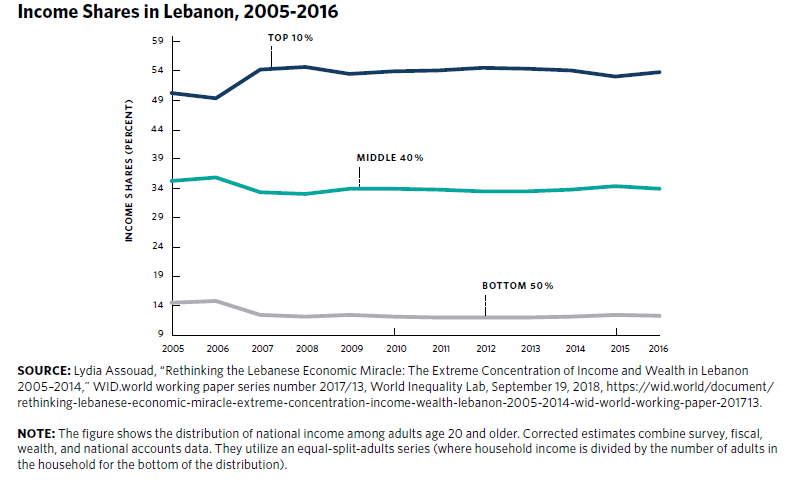Thomas Picketty’s seminal work, Capital in the Twenty-First Century (2014), has re-awakened a dormant interest in income distribution in developed and developing countries alike. That, fortunately (or unfortunately), included Lebanon, and the results are not pretty.
In her paper, Lydia Assouad (2021)[1], based on micro-fiscal data to estimate income distribution for the entire population of Lebanon between 2005 and 2016, including non-Lebanese migrant workers and refugees, arrives at results that are perhaps a bit startling. The top 10 percent of the country’s richest individuals earned between 49 and 54 percent of national income, the middle 40 percent earned between 39 and 32 percent, and the poorest 50 percent of the population earned between 12 and 14 percent. As a yearly average, the richest 10 percent pocketed more than 50 percent of all income earned in the country. By comparison, this figure stood under 35 percent in France and around 45 percent in the United States. Such a statistic places Lebanon among the countries with the highest levels of income inequality in the world, alongside South Africa and Brazil.
However, the distribution becomes less skewed when looking at only the labor income distribution (meaning wages, salaries, and pensions), the type of income that the majority of the population earns. The data indicate that the top 10 percent of labor income earners received between 41 and 45 percent of total labor income. The poorest 50 percent received between 13 and 15 percent. Interestingly, between 2005 and 2016, the fiscal data only cover between 4 and 13 percent of the total labor force. In other words, the fiscal administration covers only a small share of the total labor force, suggesting that the informal sector’s share is very large and probably larger than official estimates and, as important, that perhaps the share of the bottom 50 percent is overvalued. Also, given that in terms of total income, we saw that the share of the top 10 percent earners was higher, varying between 49 and 54 percent, then this implies that their share in other income – such as profits, rent, and interest – was much higher and as such tilted, rather expectedly, the distribution in their favor.
Of course, an interesting question is: what is the distribution of income like now, after close to five years of financial crisis? It is reasonable to assume that non-labor income was hit hard for the top 10 percent, while labor income was also badly hurt for the bottom 50 percent. However, which effect was larger, and what was its impact on the overall income distribution, only new empirical evidence can tell.
[1] “Lebanon’s Political Economy: From Predatory to Self-Devouring”, Carnegie Middle East Center.
